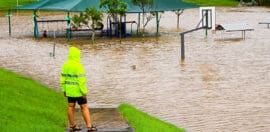Solar in the sunshine state outshines coal

9 October 2019 at 2:27 pm
Queensland solar panels are producing twice as much electricity as the state’s largest coal-fired power station, marking a new milestone for the renewables industry.
Dr Anthony Lynham, QLD state energy minister, announced on Sunday that rooftop solar and solar farms had hit a 4,000 megawatts energy capacity in the state, outstripping the Gladstone coal generator, which sits at 1,680 megawatts of capacity.
A fall in solar market prices and government subsidy schemes have seen an explosion in solar installation in the state, with more than 560,000 rooves now hosting solar systems.
Lynham said almost 2,500 households and small businesses had installed a solar battery system under the government’s solar and battery scheme that provides loans and grants, with a further 1,500 approved to install a system before the program winds up in mid 2020.
Mark Bretherton, spokesperson for the Clean Energy Council, told Pro Bono News it was positive to see the aptly named “sunshine state” making the most of the sun.
“Queensland has been setting an ambitious renewable energy target for the state and encouraging rooftop solar power for many years,” Bretherton said.
“There are challenges to overcome at every step of the way, but the enthusiasm with which Queenslanders have embraced solar suggests renewable energy is headed for a bright future.”
Lynham said Queensland was forecast to hit 20 per cent of its renewable energy target next year and was on track to achieve its 50 per cent renewable energy target by 2030.
Plans are also underway in remote Indigenous communities such as Lockhart River and Doomadgee, to swap out expensive diesel generators with solar to power the towns.
The milestone comes as a coalition of more than 20 community groups launched a campaign on Tuesday calling on state governments to end “solar lock-out”.
They argue that more than one third of Australians – renters, people living in apartment blocks, and people on low incomes – are unable to access solar energy and the benefits it provides due to costs and a lack of suitable roofing.
The coalition, led by the Community Power Agency (CPA), is demanding government support for affordable and accessible solar solutions.
A proposed solution is the use of solar gardens, which are centralised solar arrays that the public can purchase a small share of. Electricity generated by the arrays is then credited on consumer’s bills.
Nicky Ison, the founder and co-director of CPA, said this was an easy fix for governments.
“Governments can easily fix this unfair situation in Australia by funding solar garden trials and solar rebates for low-income and locked-out households,” Ison said.
“Solar energy reduces people’s electricity bills and cuts climate pollution. Everyone deserves to access these benefits, regardless of their living arrangements or income levels.”









Maybe the Clean Energy Council has missed what is happening in the real world? The Clean Energy Finance Corporation is very active if supporting both CHPs and the aged. This is but one example: Families in three regional NSW cities – Bathurst Dubbo and Orange – will benefit from 220 new highly energy efficient homes for low income families.
A significant portion of existing Housing Plus dwellings in regional NSW will also undergo clean energy retrofits so that they require less energy to operate for day-to-day living.
Tier 1 regional community housing provider Housing Plus is participating in the NSW Social and Affordable Housing Fund (SAHF) to deliver the new homes.
The homes, which will have rooftop solar and energy efficiency technologies installed, will be built to a minimum 7-Star National Housing Energy Rating System (NatHERS) standard.
Scott Morrison has never accounted for the total cost of burning hydrocarbons both Coal and Oil. His misleading and deceit are manifest by his failures to acknowledge the papers and statements coming out of the International Monetary Fund.
The IMF calculates that worldwide the fossil fuels industry receives $ 6 trillion in subsidies, Australian taxpayers subsidise part of that mind-blowing number by $42 Billion each year.
Gina Rinehart donated her subsidy to the IPA which amounts to a taxpayer-funded round-robin to indirectly fund the liberal party.
The same thing happened when Clive Palmer funded his newspaper advertisements supporting the liberals, which could not print without his taxpayer subsidies.
The other cost the PM forgets, or avoids mentioning is that eleven million people die in advanced and poverty-stricken economies each and every year.
The 2.5-micron nanoparticle pollutants are able to go straight into your bloodstream but can never be excreted until finally you cannot breathe anymore. Inhalation of these tiny particles results in serious health impacts, including premature death, aggravation of heart and lung disease, changes in lung function and increased respiratory symptoms. Particle pollution comes from tailpipe emissions, diesel exhaust, power plant emissions, wood burning and other air pollution sources, and consists of soot, aerosols, metals, acids and other microscopic particles these maybe more important immediate measures to watch than ppm CO2.
Pre-existing health conditions make people particularly susceptible to harm from particle pollution –asthma, including the chronic obstructive pulmonary disease; cardiovascular disease; and diabetes. These health conditions are thought to be exacerbated in part as a result of the inflammatory (or immune system) response generated following exposure to particulate pollution.
The Clean Air Acts requires establishment air quality standards which are protective of public health and welfare. Numerous peer-reviewed scientific studies support the conclusion that fine particulate pollution is causally associated with serious adverse health effects in humans, at exposure levels far below the current standards. The current standards do not protect human health. Maybe this is why Treasurer Josh Frydenberg simply refers to ‘Coal as cheap and reliable.’